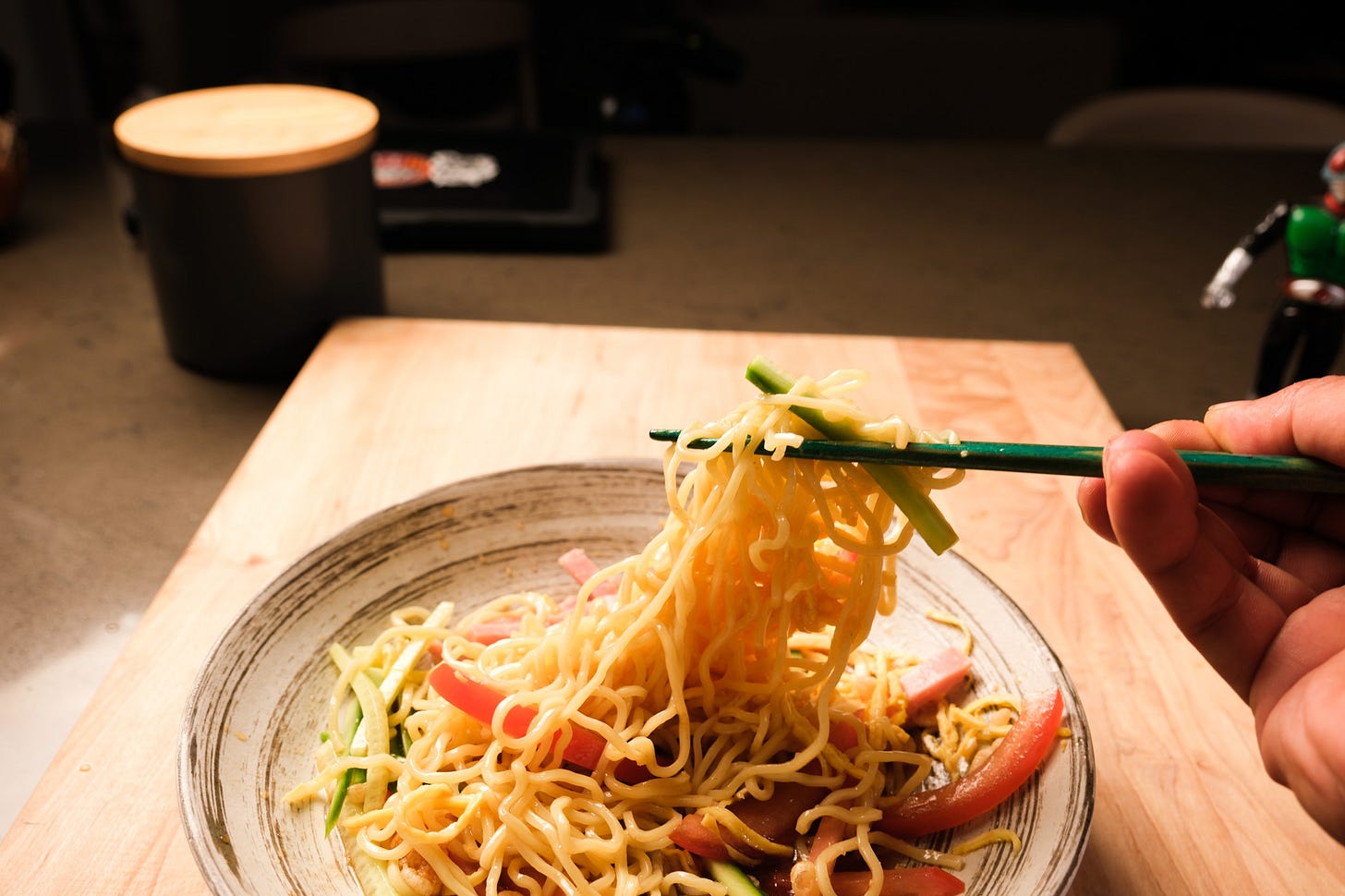Hiyashi Chuka: A Japanese Summer Classic
How to Make Hiyashi Chuka: Japan’s Iconic Cold Ramen Salad for Hot Summer Days
Hiyashi Chuka is a must-know Japanese summer dish. When the weather turns hot in Japan, this cold noodle salad starts appearing everywhere—from restaurant menus to home kitchens. It’s not just a meal, it’s a signal that summer has truly arrived.
The roots of Hiyashi Chuka trace back to the 1930s. It was introduced in Japan by restaurants seeking a way to serve ramen during the peak of summer. Inspired by Chinese cold noodle dishes, chefs adapted the concept into something distinctly Japanese. Over time, it became a seasonal staple. Walk into most ramen shops during the warmer months and you’ll likely see it as a summer special.
What makes Hiyashi Chuka so appealing is its balance—cold, chewy noodles; crisp, fresh toppings; and a tangy-sweet sauce that refreshes with every bite. The dish is vibrant and colorful, often garnished with neatly arranged strips of egg, ham, cucumber, and tomato. But the beauty of Hiyashi Chuka lies in its flexibility. The toppings can change depending on what you have on hand. Ham, chicken, shrimp, tofu—each brings its own flavor and texture to the bowl.
For me, this dish carries a deep personal connection. It was my favorite lunch growing up in the summer. I remember sitting around the table while my mom prepared it, carefully layering each topping like she was painting with ingredients. She always used ham, and I still do today, both for the taste and the memories. She would drop the noodles into ice water right after boiling, making them perfectly chewy and refreshing. That one step made all the difference.
Even now, when I make Hiyashi Chuka, it brings me back to those moments—summer afternoons, a table full of color, and the comfort of a meal that never changes even as everything else does.
If you’ve never made it before, this is a great place to start. Simple, flexible, and packed with flavor, Hiyashi Chuka is a dish worth knowing.
Hiyashi Chuka Recipe
Ingredients (Serves 2 to 3)
Noodles
Fresh ramen noodles or Chinese-style egg noodles | 2 to 3 servings
Sauce
Soy sauce | 4 tablespoons
Rice vinegar | 4 tablespoons
Mirin | 1 tablespoon
Sugar | 3 tablespoons
Water | 2 tablespoons
Fresh ginger juice | 1 teaspoon
Lemon juice | 1 teaspoon
Neutral oil (vegetable or canola) | 2 teaspoons
Sesame oil | 1 teaspoon
Toppings (adjust as desired)
Eggs (for kinshi tamago) | 1 to 2
Cucumber, julienned | 1 small
Ham, thinly sliced | 2 to 3 slices
Tomato, cut into wedges | 1 small
Tempura bits (agedama) | 2 to 3 tablespoons
Sesame seeds | to garnish
Karashi (Japanese mustard) | optional
Instructions
1. Prepare the sauce
In a small bowl, combine soy sauce, vinegar, mirin, sugar, water, ginger juice, and lemon juice. Stir until the sugar dissolves completely. Add the neutral oil and sesame oil, then mix well. Chill the sauce in the refrigerator while preparing the rest.
2. Cook the noodles
Bring a large pot of water to a boil. Cook the noodles according to the package instructions, usually 2 to 3 minutes for fresh ramen. Drain and rinse under cold running water to remove excess starch. Immediately place the noodles into a bowl of ice water to firm them up and enhance their chew. Drain thoroughly and set aside.
3. Prepare the toppings
Cook the egg into a thin sheet, let it cool, then slice into thin strips. Julienne the cucumber and slice the ham. Cut the tomato into wedges. Prepare any optional toppings you like. If using store-bought tempura bits, toast them lightly in a dry pan for extra crunch if desired.
4. Assemble the dish
Divide the noodles onto serving plates. Arrange the toppings on top in sections, keeping each ingredient visible for presentation. Pour the chilled sauce over the noodles or serve it on the side. Sprinkle with sesame seeds and tempura bits. Serve with a small amount of karashi if using.
Notes
This dish is highly adaptable. Use any protein you prefer—grilled chicken, poached shrimp, tofu, or even leftover roast pork.
Chilling the noodles in ice water is key to the texture. Do not skip that step.
The sauce can be made in advance and stored in the refrigerator for up to three days.
Hiyashi Chuka is more than just a way to cool down in summer. It’s a celebration of the season, a chance to be creative, and a dish that carries memories for many. Whether you’re making it for the first time or rediscovering a favorite, this is a recipe that never goes out of style.








Your descriptive post makes me crave this cold noodle salad! Thanks for sharing your summer memories & your recipe. Is your mom the person that inspired you to be a chef? She must be very proud of you.
What is “fresh” ramen?